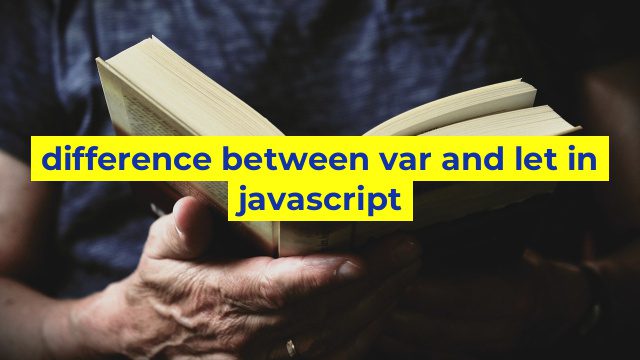Understanding the Difference between var and let in JavaScript
Introduction
JavaScript is an essential programming language for creating interactive web pages. A significant part of JavaScript is the use of variables, which allow developers to store values and use them later in the program. When it comes to declaring variables in JavaScript, there are two keywords: var and let. Although these two keywords can be used interchangeably in certain situations, they have significant differences.
What is var in JavaScript?
var is the traditional way of declaring variables in JavaScript. When you declare a variable with var, you can use it anywhere within the scope of the function.
For example:
function foo() {
var x = 5;
console.log(x);
}
foo(); // prints 5
console.log(x); // ReferenceError: x is not defined
In the above case, the variable x is defined within the function foo’s scope. Therefore, it can only be accessed within the function.
What is let in JavaScript?
let, on the other hand, was introduced in ECMAScript 6 as an alternative to var. let also declares a variable but allows for more fine-grained control over the variable scope.
For example:
function foo() {
let x = 5;
if (x === 5) {
let x = 10;
console.log(x); // 10
}
console.log(x); // 5
}
foo();
In the above code block, the variable x is defined as 5 within the scope of the function. However, within the if statement, another variable x is defined, and it shadows the previous value of x. Therefore, the first console.log statement prints 10 because it’s within the scope of the if block. In contrast, the second console.log statement prints 5 because it’s outside the if block scope.
The Key Differences between var and let
The primary difference between var and let is how they handle scope.
With var, variables are function-scoped, which means the variable exists within the scope of the function it’s defined in. This also means that attempting to access a var variable outside its scope will result in a ReferenceError.
With let, variables are block-scoped, which means they exist within the block they’re defined in. A block can be a function, an if statement, a loop, or a plain code block. Unlike var, attempting to access a let variable outside its scope will result in a ReferenceError.
So, when do you use var and when should you use let?
If you need a variable that is accessible within the scope of the entire function, use var. But if you only require a variable within a specific code block, use let.
Conclusion
In summary, whether you should use var or let in JavaScript depends on the scope of the variable you need. While var is the traditional keyword for declaring variables in JavaScript, let offers a more fine-grained control over variable scope. Understanding the difference between var and let helps you write clean, maintainable, and efficient code.
Table difference between var and let in javascript
| Variable | let | var |
|---|---|---|
| Declaration | Block scope | Function scope or global scope |
| Hoisting | No hoisting | Hoisting allowed |
| Re-declaration | Not allowed | Allowed |
| Initializing | Optional | Optional |
| Global object | No property added | Added as a property of the global object |
| Usage | Use let for local variables and block-scoped variables | Use var for function-scoped variables and global variables |


